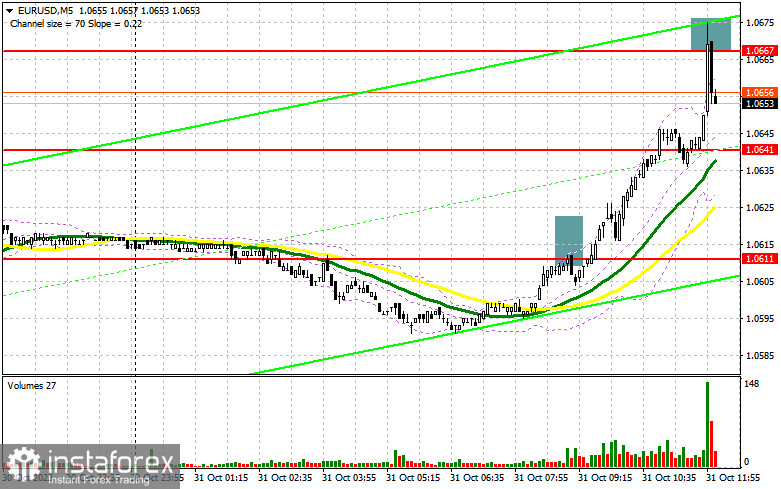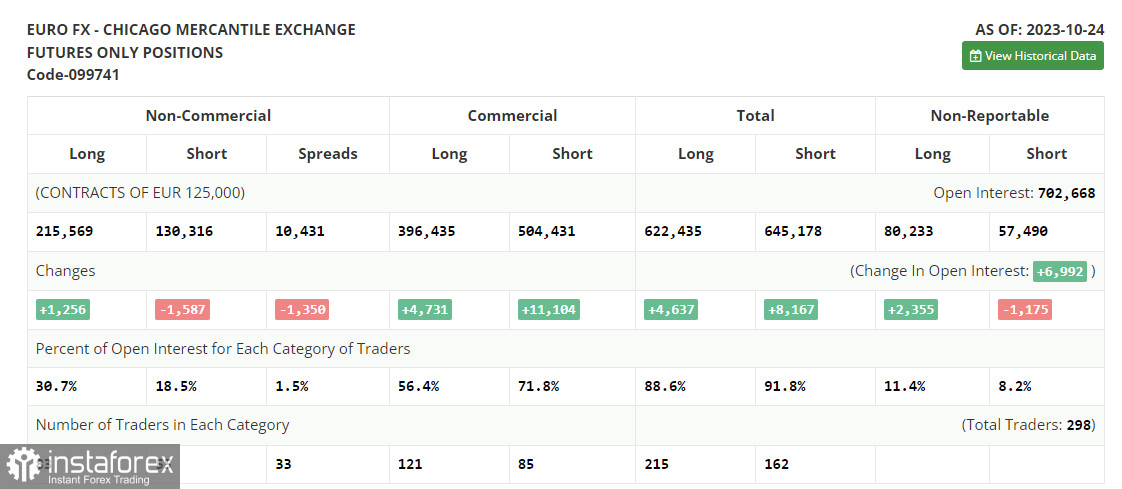In my morning forecast, I emphasized the level of 1.0611 and recommended making entry decisions based on it. Let's take a look at the 5-minute chart and analyze what happened there. The rise and formation of a false breakout around 1.0611 led to a sell signal, but the downward movement never occurred. As a result, the trade resulted in losses. However, selling on the rebound from 1.0667 allowed us to offset those losses. The technical picture was slightly revised for the second half of the day.

To open long positions on EUR/USD:
The euro rose after news that inflation in the Eurozone continued to decline faster than expected by economists. However, GDP data nullified some of the traders' optimism, as there was a contraction in the economy in the third quarter. Ahead, we have some interesting statistics coming in from the United States. Still, it's unlikely that major sellers will return to the market before tomorrow's Federal Reserve meeting. Data on the consumer confidence index and the housing price index in the United States could lead to a significant correction in the euro, as well as good figures on the S&P/Case-Shiller 20-city home price index and the Chicago PMI. If that happens, I expect buyers to show up around 1.0637. A false breakout there would provide a good entry point for long positions in anticipation of another test of the resistance at 1.0667, which we already dropped from today. A breakthrough and an update from top to bottom of this range will give us a chance for another jump with an update of last week's maximum around 1.0693, where I will take profit. In the case of a decline in EUR/USD and the absence of activity at 1.0637, which is unlikely, the pressure on the euro will return, leading to a more significant downward movement towards 1.0606, where the moving averages are playing on the buyer's side. Only the formation of a false breakout will create a signal to enter the market. I will consider opening long positions on a rebound from 1.0575 with a target of an upward correction of 30-35 points within the day.
To open short positions on EUR/USD:
Sellers tried to defend their positions, but unfortunately, the data did its job. There is an active struggle going on now around the 1.0667 level, and letting it slip could mean losing control of the market altogether. For this reason, only one more false breakout formation at the level of 1.0586, along with strong US data, especially in the housing market, will signal a sell-off with a move down to the nearest support at 1.0637. After a breakthrough and consolidation below this range, as well as a bottom-up retest, I expect to get another sell signal with an exit at 1.0606. The ultimate target will be a minimum of 1.0575, where I will take a profit. In the event of further upward movement in EUR/USD during the American session and the absence of bears at 1.0667, which seems to be the case right now, buyers will surely try to update the monthly maximum of 1.0693. You can sell there, but only after an unsuccessful consolidation and a false breakout. I will consider opening short positions on a rebound from 1.0734 with a downward correction target of 30-35 points.

In the Commitment of Traders (COT) report for October 24, long positions increased and short positions decreased. Considering that everyone expected the European Central Bank to halt its rate hike cycle, its decision did not significantly impact the market's positioning. And as we can see, it even helped the euro regain its position against the US dollar. This week, the Federal Reserve System of the United States will hold a meeting at which similar decisions to maintain current policies are expected. However, based on post-US data, it's possible that committee members might hint at the possibility of one final rate hike in December this year, which would strengthen the dollar. The COT report indicates that long non-commercial positions increased by 1,256 to 215,569, while short non-commercial positions decreased by 1,587 to 130,316. As a result, the spread between long and short positions fell by 1,350. The closing price increased and reached 1.0613, confirming the upward correction of the euro.

Indicator signals:
Moving Averages
Trading is conducted above the 30 and 50-day moving averages, indicating the possibility of further euro growth.
Note: The author uses the 30 and 50-period moving averages on the 1-hour chart (H1), which differs from the general definition of classical daily moving averages on the daily chart (D1).
Bollinger Bands
In case of a decline, the lower boundary of the indicator around 1.0575 will serve as support.
Indicator descriptions:
- Moving average (determines the current trend by smoothing volatility and noise). Period 50. Marked in yellow on the chart.
- Moving average (determines the current trend by smoothing volatility and noise). Period 30. Marked in green on the chart.
- MACD indicator (Moving Average Convergence/Divergence - convergence/divergence of moving averages). Fast EMA period 12. Slow EMA period 26. SMA period 9.
- Bollinger Bands. Period 20.
- Non-commercial traders - speculators, such as individual traders, hedge funds, and large institutions using the futures market for speculative purposes and meeting specific requirements.
- Long non-commercial positions represent the total long open positions of non-commercial traders.
- Short non-commercial positions represent the total short open positions of non-commercial traders.
- The total non-commercial net position is the difference between the short and long positions of non-commercial traders.
 English
English 
 Русский
Русский Bahasa Indonesia
Bahasa Indonesia Bahasa Malay
Bahasa Malay ไทย
ไทย Español
Español Deutsch
Deutsch Български
Български Français
Français Tiếng Việt
Tiếng Việt 中文
中文 বাংলা
বাংলা हिन्दी
हिन्दी Čeština
Čeština Українська
Українська Română
Română

